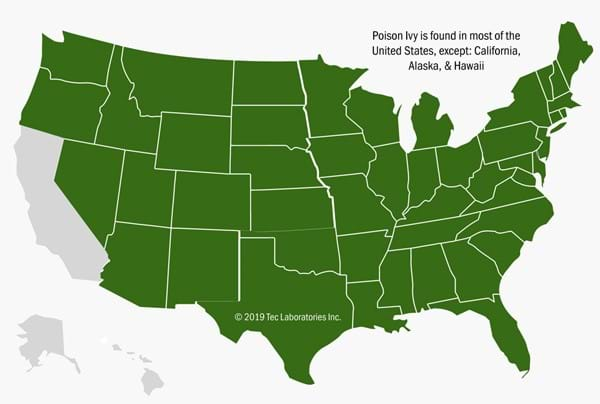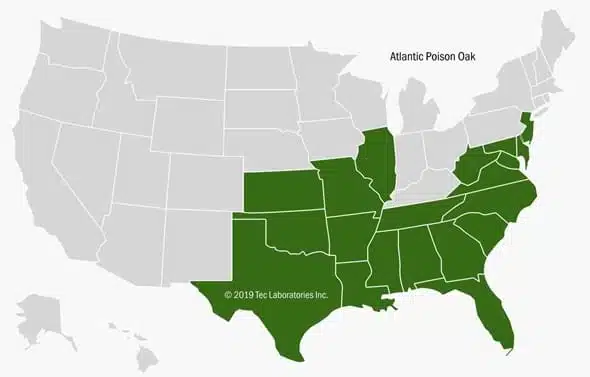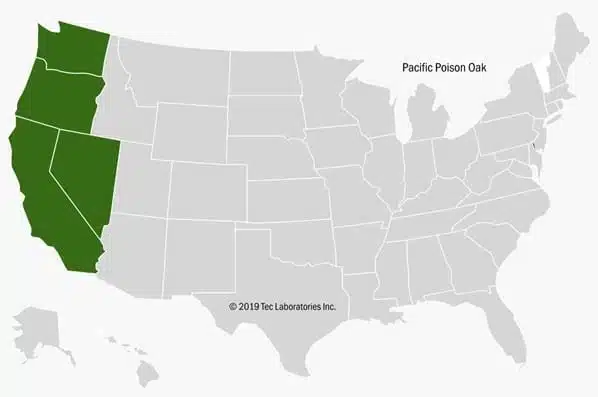Outdoor Itch Resource Center
Welcome to the outdoor itch resource center! Our goal is to help you stay itch and pain-free. We offer guides and how-to's to help you understand and avoid poison ivy and oak.
Where Do I Find Poison Ivy, Oak, and Sumac Plants?
When you’re out enjoying the outdoors, the last thing you want is a rash from poison ivy, oak, or sumac. These plants are common across the United States and are known for producing urushiol oil, which can cause a painful and itchy rash. Let's explore the history of these plants, how they spread across the U.S., and how to identify them in different regions.
Understanding where these plants originate from and how they have expanded over time will help you better avoid them, whether hiking, camping, or working in your yard. Read on to learn more about poison ivy, oak, and sumac, and use the accompanying U.S. maps to see where these plants are most commonly found today.
Poison Ivy in the United States

Poison ivy is one of the most recognizable plants in the U.S., infamous for its shiny leaves and the classic saying: “Leaves of three, let it be.” Poison ivy grows in every state except Hawaii and Alaska, making it one of the most widespread plants that cause skin irritation nationwide.
European settlers first documented poison ivy in North America in the early 1600s, though it was well-known to Native Americans long before that. The plant thrives in temperate climates, which explains why it’s so common in the eastern and central U.S. It prefers areas like forest edges, fields, and roadsides, but it can also climb fences or walls in urban areas.
Poison Ivy Map

Where Does Poison Ivy Grow?
Poison ivy grows in various environments, from dense forests to suburban backyards. It can appear as a ground cover or as a vine that climbs trees, fences, and buildings. Here’s where you’re most likely to find it:
Eastern and Central U.S.: Poison ivy is most prevalent in the eastern states, stretching from Maine to Florida and as far west as Texas and the Dakotas.
Western U.S.: While not as common in the West, poison ivy does grow in parts of California, Oregon, and other states, though poison oak tends to dominate this region.
Poison Oak: A Regional Irritant

Poison oak, like poison ivy, contains urushiol oil that can cause similar skin irritation and rashes. It is more commonly found in the western U.S. but also appears in some parts of the East. Although poison oak is often mistaken for poison ivy, its leaves tend to resemble those of an oak tree, with a lobed shape that differentiates them from poison ivy’s smoother leaves.
Poison Oak Map


Where Does Poison Oak Grow?
Western U.S.: The variety of the west (Toxicodendron diversilobum) is abundant along the Pacific Coast, especially in California and Oregon. It thrives in woodlands and forests, often near streams and meadows. Poison oak can grow as a low shrub or as a climbing vine.
Southeastern U.S.: The eastern variety (Toxicodendron pubescens) grows mainly in the Southeast, particularly in sandy soils. You’ll find it in open fields, roads, and dry, wooded areas.
While poison oak is not as widespread as poison ivy, it’s essential to recognize its characteristics if you live in or are visiting regions where it thrives.
Poison Sumac: The Lesser-Known Threat

Poison sumac is less common than poison ivy or oak but can cause a more severe reaction. Poison sumac doesn’t follow the “leaves of three” rule, making it harder to identify. Instead, it has 7 to 13 leaflets arranged in pairs, with one at the tip of the stem. Poison sumac thrives in wet, swampy areas, so you’ll likely encounter it in marshes or bogs.
Poison Sumac Map

Where Does Poison Sumac Grow?
Southeastern U.S.: Poison sumac is most common in the southeastern United States, where it grows in wetland areas like swamps and bogs.
Northern U.S.: You can also find poison sumac in parts of the north of the U.S., especially around the Great Lakes and other wet, forested regions.
The Origins and Spread of Poison Ivy, Oak, and Sumac
The Toxicodendron genus plants, including poison ivy, oak, and sumac, are native to North America and have existed on the continent for millions of years. Fossil records suggest that these plants have been around for a long time, long before humans began encountering them.
As settlers arrived in North America and began cultivating the land, poison ivy and oak spread to new areas. The disturbance of natural landscapes, from road-building to deforestation, created the perfect conditions for these plants to grow. Today, poison ivy is found in most states, while poison oak dominates in the western U.S., and poison sumac is more regionally confined to wet, swampy environments.
How to Protect Yourself from Poison Ivy, Oak, and Sumac
Knowing where these plants grow is half the battle; the other half is knowing how to avoid exposure. Here are a few practical steps you can take:
- Learn to Identify the Plants: Familiarize yourself with the appearance of poison ivy, oak, and sumac throughout the year. Knowing what to look for will help you avoid them during hikes or yard work.
- Wear Protective Clothing: When working in areas where these plants may grow, wear long sleeves, pants, and gloves to reduce skin exposure.
- Use Tecnu Detox Wipes for Quick Cleanup: If you suspect you’ve come into contact with poison ivy, oak, or sumac, use Tecnu Detox Wipes immediately to remove the urushiol oil from your skin before it has a chance to cause a rash. These wipes are portable and easy to use, making them an essential tool for anyone spending time outdoors.
Poison ivy, oak, and sumac are more than nuisances; they can be found across the United States and can cause painful rashes if improperly avoided. By learning where these plants grow and how to identify them, you can better protect yourself while enjoying the outdoors. Keep Tecnu Detox Wipes on hand for quick cleanup and to prevent the spread of urushiol oil.
- Choosing a selection results in a full page refresh.
- Opens in a new window.
